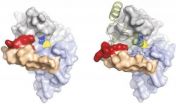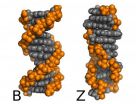(Press-News.org) PHILADELPHIA—Elevated levels of Cyclin D1b could function as a novel biomarker of lethal metastatic disease in prostate cancer patients, according to a pre-clinical study published ahead of print on December 21 in the Journal of Clinical Investigation by researchers at the Kimmel Cancer Center at Jefferson.
The group, headed by Karen E. Knudsen, Ph.D., Professor and Hilary Koprowski Chair, Departments of Cancer Biology, Urology, and Radiation Oncology at Thomas Jefferson University and Deputy Director for Basic Science at the KCC, found that Cyclin D1b, a variant of the cell cycle regulator Cyclin D1a, functions independently of the cell cycle to promote metastasis in both early and late stage prostate cancer.
Rather, Cyclin D1b, but not Cyclin D1a, regulates a large gene network, the researchers found, which was shown to cooperate with androgen receptor (AR) signaling to fuel metastatic progression in multiple models of prostate cancer.
Studies have shown that Cyclin D1b expression is elevated in early stages of prostate cancer (in up to 30% of primary disease), and researchers have now demonstrated that this occurs more frequently in late stage castration-resistant prostate cancer: up to 80%.
Cyclin D1b expression is also highly correlated with that of the pro-metastatic gene SNAI2 (Slug), which the group identified as regulated by cooperative signaling between Cyclin D1b and AR.
"Numerous clinical and pre-clinical studies have effectively demonstrated that AR signaling is critical for progression to metastatic disease, but our knowledge of AR targets which can induce metastatic phenotypes is limited," said Dr. Knudsen. "Our data describe how cross talk between the cell cycle and AR can rewire the AR signaling axis to enhance the expression of genes which elicit metastasis in both early and castration resistant prostate cancer models."
"We found that Cyclin D1b can directly promote AR dependent expression of the gene SNAI2 (Slug), which dramatically increased metastatic events to soft tissues in animal models," she added.
Metastatic castration resistant prostate cancer represents the most lethal form of the disease, which arises when AR is reactivated despite continued hormone therapy.
Soft tissue metastasis to the liver and lung represents a particularly aggressive form of prostate cancer, whose presence predicts for decreased survival time in prostate cancer patients.
Currently, there is little knowledge as to how these metastatic events occur, and identification of pathways and biomarkers of this lethal event could greatly benefit prostate cancer patients.
Using various in vitro and in vivo models, researchers found that Slug enhances the ability of cells to colonize soft tissues, which resulted in a higher incidence of metastasis in the liver and lung.
Given the inability to manage AR signaling in metastatic castration resistant prostate cancer, Slug driven pathways could be leveraged to dramatically limit the incidence of soft tissue metastasis and improve patient morbidity and mortality, researchers believe.
"Identification of AR driven pathways which mediate metastatic progression represents a significant leap forward in our attempts to effectively manage prostate cancer progression," said Dr. Knudsen. "Cyclin D1b and Slug can likely be used as biomarkers to identify patients with an increased risk of metastasis, and will eventually provide us with novel "druggable" targets downstream of AR and Slug which can be exploited to dramatically reduce the incidence of these lethal metastatic tumors."
INFORMATION:
This study was completed as a result of an inter-institutional team effort, including the contributions of the lead author and graduate student Michael A. Augello of the Department of Cancer Biology at Thomas Jefferson University, as well as key collaborators: Dr. Felix Feng (University of Michigan), Dr. Alessandro Fatatis (Drexel University), Dr. Tapio Visakorpi (University of Tampere), Dr. Donald McDonnell (Duke University), Dr. C. Burd (University of Ohio), Dr. D E. Frigo (University of Houston) and Dr. Ruth Birbe of Thomas Jefferson University.
Thomas Jefferson University researchers discover new pathways that drive metastatic prostate cancer
Newly-discovered Cyclin D1b/hormone receptor pathways axis promotes aggressive forms of prostate cancer
2012-12-21
ELSE PRESS RELEASES FROM THIS DATE:
Hawaiian Islands are dissolving, study says
2012-12-21
Someday, Oahu's Koolau and Waianae mountains will be reduced to nothing more than a flat, low-lying island like Midway.
But erosion isn't the biggest culprit. Instead, scientists say, the mountains of Oahu are actually dissolving from within.
"We tried to figure out how fast the island is going away and what the influence of climate is on that rate," said Brigham Young University geologist Steve Nelson. "More material is dissolving from those islands than what is being carried off through erosion."
The research pitted groundwater against stream water to see which ...
miR-205 can be responsible for breast cancer
2012-12-21
Over the past couple of years research into miRNAs has become increasingly diversified and attracted a great number of research articles across genetics and medicine. This should hardly come as a surprise to any scientist in the field, especially since it has become clear that miRNAs, a recently discovered class of non-coding RNAS, are represented in nearly all cellular functions and molecular pathways. A growing list of reports demonstrates that microRNAs play a critical role in cancer initiation and progression, and that miRNA alterations are ubiquitous in human cancers. ...
May the force be with the atomic probe
2012-12-21
Theoretical physicist Elad Eizner from Ben Gurion University, Israel, and colleagues created models to study the attractive forces affecting atoms located at a wide range of distances from a surface, in the hundreds of nanometers range. Their results, about to be published in EPJ D, show that these forces depend on electron diffusion, regardless of whether the surface is conducting or not. Ultimately, these findings could contribute to designing minimally invasive surface probes.
Bombarding a surface with atoms helps us understand the distribution of its electrons and ...
Carin Göring's remains identified by researchers at Uppsala University
2012-12-21
The putative remains of Carin Göring, wife of Nazi leader Herman Göring, were found in 1991 at a site close to where she had been buried. In a recently published article, Maria Allen, professor of forensic genetics at Uppsala University, Sweden, and her associates present evidence supporting that it is Carin Göring's remains that have been identified.
The Swedish Carin Göring was married to the well-known Nazi leader Herman Göring. When she died in 1931 she was buried in Stockholm, but three years later Herman Göring had her remains moved to his residence Karinhall outside ...
Fighting sleeping sickness with X-ray lasers
2012-12-21
This press release is available in German.
Using the world's most powerful X-ray free-electron laser, an international team of researchers, including scientists of the Max Planck Institute for Medical Research in Heidelberg, has obtained new insight into the structure of a medicinally important protein that may serve as a blueprint for the development of drugs to fight sleeping sickness. Science magazine have chosen the experimental study as one of the top ten scientific breakthroughs of the year.
Sleeping sickness is caused by the unicellular organism Trypanosoma ...
New calculations solve an old problem with DNA
2012-12-21
In a recent publication, researchers achieved new accuracy in the ability to measure energy differences between states of molecules, thus predicting which states will be observed.
It has been known since the seventies that excessive salt causes DNA to reverse its twist, from a right-handed spiral to a left-handed one. DNA in the Z form is treated by our natural repair enzymes as damaged, and is therefore usually deleted from the cell. Deletion of genetic material can lead to cancer or to other problems, so the B-Z transition is no mere curiosity. However such is the ...
Ups and downs of biodiversity after mass extinction
2012-12-21
The climate after the largest mass extinction so far 252 million years ago was cool, later very warm and then cool again. Thanks to the cooler temperatures, the diversity of marine fauna ballooned, as paleontologists from the University of Zurich have reconstructed. The warmer climate, coupled with a high CO2 level in the atmosphere, initially gave rise to new, short-lived species. In the longer term, however, this climate change had an adverse effect on biodiversi-ty and caused species to become extinct.
Until now, it was always assumed that it took flora and fauna ...
Strength training improves vascular function in young black men
2012-12-21
CHAMPAIGN, Ill. — Six weeks of weight training can significantly improve blood markers of cardiovascular health in young African-American men, researchers report in the Journal of Human Hypertension.
The researchers measured blood markers associated with inflammation, immune response or the remodeling of arteries that normally occur after tissue damage, infection or other types of stress. They found that levels of two of these markers dropped significantly in African-American men but not in Caucasian men after six weeks of resistance training.
"This suggests that resistance ...
Physicists take photonic topological insulators to the next level
2012-12-21
AUSTIN, Texas—Researchers at The University of Texas at Austin have designed a simulation that for the first time emulates key properties of electronic topological insulators.
Their simulation, which was described this week in Nature Materials, is part of a rapidly moving scientific race to understand and exploit the potential of topological insulators, which are a state of matter that was only discovered in the past decade. These insulators may enable dramatic advances in quantum computing and spintronics.
"The discovery of these materials, which are insulators in ...
Targeted gene silencing drugs are more than 500 times more effective with new delivery method
2012-12-21
New Rochelle, NY, December 20, 2012—Small interfering RNAs (siRNAs) are a potent new drug class that can silence a disease-causing gene, but delivering them to a target cell can be challenging. An innovative delivery approach that dramatically increases the efficacy of an siRNA drug targeted to the liver and has made it possible to test the drug in non-human primates is described in an article in Nucleic Acid Therapeutics, a peer-reviewed journal from Mary Ann Liebert, Inc. publishers (http://www.liebertpub.com). The article is available on the Nucleic Acid Therapeutics ...
LAST 30 PRESS RELEASES:
Tracing the quick synthesis of an industrially important catalyst
New software sheds light on cancer’s hidden genetic networks
UT Health San Antonio awarded $3 million in CPRIT grants to bolster cancer research and prevention efforts in South Texas
Third symposium spotlights global challenge of new contaminants in China’s fight against pollution
From straw to soil harmony: International team reveals how biochar supercharges carbon-smart farming
Myeloma: How AI is redrawing the map of cancer care
Manhattan E. Charurat, Ph.D., MHS invested as the Homer and Martha Gudelsky Distinguished Professor in Medicine at the University of Maryland School of Medicine
Insilico Medicine’s Pharma.AI Q4 Winter Launch Recap: Revolutionizing drug discovery with cutting-edge AI innovations, accelerating the path to pharmaceutical superintelligence
Nanoplastics have diet-dependent impacts on digestive system health
Brain neuron death occurs throughout life and increases with age, a natural human protein drug may halt neuron death in Alzheimer’s disease
SPIE and CLP announce the recipients of the 2025 Advanced Photonics Young Innovator Award
Lessons from the Caldor Fire’s Christmas Valley ‘Miracle’
Ant societies rose by trading individual protection for collective power
Research reveals how ancient viral DNA shapes early embryonic development
A molecular gatekeeper that controls protein synthesis
New ‘cloaking device’ concept to shield sensitive tech from magnetic fields
Researchers show impact of mountain building and climate change on alpine biodiversity
Study models the transition from Neanderthals to modern humans in Europe
University of Phoenix College of Doctoral Studies releases white paper on AI-driven skilling to reduce burnout and restore worker autonomy
AIs fail at the game of visual “telephone”
The levers for a sustainable food system
Potential changes in US homelessness by ending federal support for housing first programs
Vulnerability of large language models to prompt injection when providing medical advice
Researchers develop new system for high-energy-density, long-life, multi-electron transfer bromine-based flow batteries
Ending federal support for housing first programs could increase U.S. homelessness by 5% in one year, new JAMA study finds
New research uncovers molecular ‘safety switch’ shielding cancers from immune attack
Bacteria resisting viral infection can still sink carbon to ocean floor
Younger biological age may increase depression risk in older women during COVID-19
Bharat Innovates 2026 National Basecamp Showcases India’s Most Promising Deep-Tech Ventures
Here’s what determines whether your income level rises or falls
[Press-News.org] Thomas Jefferson University researchers discover new pathways that drive metastatic prostate cancerNewly-discovered Cyclin D1b/hormone receptor pathways axis promotes aggressive forms of prostate cancer





